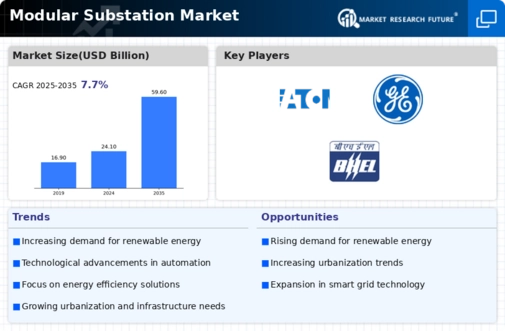Market Growth Projections
The Global Modular Substation Market Industry is projected to experience substantial growth, with estimates indicating a rise from 24.1 USD Billion in 2024 to 59.6 USD Billion by 2035. This growth trajectory reflects the increasing adoption of modular substations across various sectors, driven by factors such as urbanization, renewable energy integration, and technological advancements. The anticipated compound annual growth rate of 8.57% from 2025 to 2035 underscores the market's potential as stakeholders recognize the benefits of modular solutions in enhancing energy distribution efficiency and reliability. This upward trend in market value highlights the growing importance of modular substations in the global energy landscape.
Rising Demand for Renewable Energy
The transition towards renewable energy sources is a pivotal driver for the Global Modular Substation Market Industry. As countries strive to meet their renewable energy targets, modular substations offer a flexible and efficient solution for integrating renewable sources such as wind and solar into the grid. This shift is evidenced by the increasing investments in renewable energy infrastructure, which are projected to reach 24.1 USD Billion in 2024. The modular design facilitates quicker deployment and scalability, aligning with the global push for sustainable energy solutions. Consequently, the demand for modular substations is expected to surge as utilities adapt to the evolving energy landscape.
Urbanization and Infrastructure Development
Rapid urbanization and infrastructure development are significant contributors to the growth of the Global Modular Substation Market Industry. As urban populations expand, the demand for reliable electricity supply increases, necessitating the deployment of efficient substations. Modular substations, with their compact design and ease of installation, are particularly suited for urban environments where space is limited. This trend is reflected in various global initiatives aimed at modernizing electrical infrastructure to support growing urban centers. The anticipated growth in urban areas is likely to drive the market, as modular solutions provide a viable answer to the challenges posed by urban electricity demands.
Government Initiatives and Regulatory Support
Government initiatives and regulatory support play a crucial role in driving the Global Modular Substation Market Industry. Many governments are implementing policies that encourage the adoption of modular substations as part of their energy transition strategies. These initiatives often include financial incentives, grants, and streamlined permitting processes aimed at facilitating the deployment of modular solutions. For instance, various countries are setting ambitious targets for reducing carbon emissions, which indirectly boosts the demand for modular substations. As regulatory frameworks evolve to support sustainable energy practices, the market is poised for substantial growth, aligning with global sustainability goals.
Increased Investment in Smart Grid Technologies
The increasing investment in smart grid technologies is a key driver of the Global Modular Substation Market Industry. Smart grids enhance the efficiency and reliability of electricity distribution, and modular substations are integral to this modernization effort. By enabling better integration of distributed energy resources and improving grid resilience, modular substations support the transition to smarter energy systems. The global market for smart grid technologies is expected to expand significantly, further propelling the demand for modular substations. As utilities invest in these technologies, the modular substation market is likely to benefit from the growing emphasis on grid modernization.
Technological Advancements in Substation Design
Technological advancements in substation design and construction are reshaping the Global Modular Substation Market Industry. Innovations such as digital monitoring systems, automation, and enhanced safety features are making modular substations more attractive to utilities. These advancements not only improve operational efficiency but also reduce maintenance costs, thereby appealing to a broader range of stakeholders. As the industry embraces these technologies, the market is expected to witness a compound annual growth rate of 8.57% from 2025 to 2035. This growth is indicative of the increasing reliance on advanced technologies to optimize energy distribution and management.













